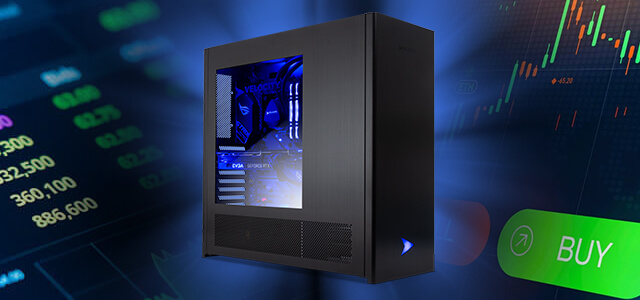
The prospect of building a workstation for finance, trading, or other high demand office applications can be overwhelming. What components should you focus on to maximize value/performance? How should the build differ from a traditional gaming PC or even a content creation workstation? Here’s a quick guide:

Workstations for Finance
Most finance applications – think Excel spreadsheets, Quickbooks, Quicken, etc. – are not especially hardware intensive. But that doesn’t mean that component selection is unimportant – quite the opposite! A carefully selected set of components will not only yield the performance you need to increase your productivity, but the stability you need to get things done. Here’s what we recommend focusing on, in this order:
- Processor – think of the processor (aka CPU) as the brain of the PC where it handles all standard computational tasks. Generally speaking, a faster processor (more GHz) will equal faster workstation performance. And for the most part, core count will be largely irrelevant for all but the heaviest multitaskers since most finance applications are primarily single threaded, meaning they only access one core/thread at a time.
Recommended CPUs – Intel Core i5-12600k, Intel Core i5-12400, AMD Ryzen 5600G
- Memory – System memory (aka RAM) is where your system stores short term information for quick access. Applications use RAM while open, so it’s important to have enough RAM capacity to handle your level of multitasking and prevent sluggishness.
Recommended RAM – 16GB DDR4-3200 for normal users, 32GB for power users
- Hard Drive – Applications and files live in the hard drive. Capacity is the obvious spec most people know, but these days, storage speed is just as important. The faster the drive, the faster your PC will be able to launch applications and open files.
Recommended Hard Drives – Crucial P2 NVMe SSD, Samsung 980 Pro
- CPU Cooling – Cooling is often ignored, especially in those big brand PCs, but it absolutely shouldn’t be. Any higher demand application will tax the processor, and the byproduct of this is heat. Proper heat dissipation from the processor is vital to long term stability and longevity of any PC.
Recommended Coolers – Arctic Cooling Freezer, AIO liquid cooler
- Configure our ProMagix Eco20 – AMD-based, budget friendly finance workstation
- Configure our ProMagix HD60 – AMD or Intel workstation with tons of upgrade options

Day Trading Workstations
Workstations for day traders will follow the same basic set of requirements, but with a few additions/changes to maximize productivity. Notably:
- Graphics card – While trading does not require the ultra-fast video processing that a gaming PC may, it’s important to choose a discrete graphics card that supports the number of monitors you’re running. Most traders find four displays to be adequate, but for more, you’ll need two cards.
Recommended Graphics Cards – NVIDIA Quadro T1000 (supports four displays)
- Processor – Whereas CPU core count was largely irrelevant for standard finance workstations, it’s a much more important spec when used for trading. This is because the heavy multitasking of most trading workflows can be optimized and accelerated by a 6-8 core processor. Core speed shouldn’t be ignored either, as fractions of second can often make the difference between winning and losing a trade.
Recommended Processor – Intel Core i7-12700k, AMD Ryzen 9 5900X
- Configure our TraderPro – Our traditional day trading workstation
- Configure our ProMagix HD60 – AMD or Intel workstation with tons of upgrade options
Every user has different needs, budget restrictions, and requirements. That’s why we still build every PC to order, just like when we started in 1997. Feel free to reach out to our team for configuration questions and assistance. We’re here to help!
Josh Covington
Latest posts by Josh Covington (see all)
- What is CUDIMM? - January 29, 2025
- X870 vs B850: Choosing the Right Motherboard for Your Build - January 17, 2025
- How Much Power Supply do I Need? - January 15, 2025
Great insights into high-performance workstations for finance and trading! Powerful specs and reliability make a huge difference. Well-explained!